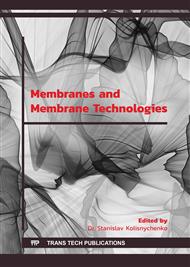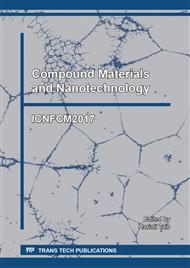[1]
A. Cho, Helium-3 shortage could put freeze on low-temperature research, Science 326 (2009) 778-779.
DOI: 10.1126/science.326_778
Google Scholar
[2]
N.K. Das, H. Chaudhuri, R. Bhandari, D. Ghose, P. Sen, B. Sinha, Purification of helium from natural gas by pressure swing adsorption, Curr. Sci. 95 (2008) 1684-1687.
Google Scholar
[3]
G. Liu, W. Jin, N. Xu, Two-dimensional-material membranes: a new family of high-performance separation membranes, Angew. Chem. Int. Ed. 55 (2016) 13384-13397.
DOI: 10.1002/anie.201600438
Google Scholar
[4]
W. Hu, X.J. Wu, Z.Y. Li, J.L. Yang, Helium separation via porous silicene based ultimate membrane, Nanoscale 5 (2013) 9062-9066.
DOI: 10.1039/c3nr02326e
Google Scholar
[5]
L. Zhu, X. Chang, D.L. He, Q.Z. Xue, X.F. Li, Y.K. Jin, H.X. Zheng, C.C. Ling, Defective germanene as a high-efficiency helium separation membrane: a first-principles study, Nanotechnology 28 (2017) 135703.
DOI: 10.1088/1361-6528/aa5fae
Google Scholar
[6]
L. Zhu, Q.Z. Xue, X.F. Li, T.T. Wu, Y.K. Jin, W. Xing, C2N: an excellent two-dimensional monolayer membrane for He separation, J. Mater. Chem. A 3 (2015) 21351-21356.
DOI: 10.1039/c5ta05700k
Google Scholar
[7]
F. Li, Y.Y. Qu, Mi.W. Zhao, Efficient helium separation of graphitic carbon nitride membrane, Carbon 95 (2015) 51-57.
DOI: 10.1016/j.carbon.2015.08.013
Google Scholar
[8]
Y. Wang, J.P. Li, Q.Y. Yang, C.L. Zhong, Two-dimensional covalent triazine framework membrane for helium separation and hydrogen purification, ACS Appl. Mater. Interfaces 8 (2016) 8694-8701.
DOI: 10.1021/acsami.6b00657
Google Scholar
[9]
M. Long, L. Tang, D. Wang, Y. Li, Z. Shuai, Electronic structure and carrier mobility in graphdiyne sheet and nanoribbons: theoretical predictions, ACS Nano 5 (2011) 2593-2600.
DOI: 10.1021/nn102472s
Google Scholar
[10]
M. Bartolomei, E. Carmona-Novillo, M.I. Hernández, J. Campos-Martínez, F. Pirani, G. Giorgi, Graphdiyne pores: ad hoc, openings for helium separation applications, J. Phys. Chem. C 118(2014) 29966-29972.
DOI: 10.1021/jp510124e
Google Scholar
[11]
J.P. Perdew, K. Burke, M. Ernzerhof, Generalized gradient approximation made simple, Phys. Rev. Lett. 77 (1996) 3865.
DOI: 10.1103/physrevlett.77.3865
Google Scholar
[12]
A. Tkatchenko, M. Scheffler, Accurate molecular van der Waals interactions from ground-state electron density and free-atom reference data, Phys. Rev. Lett. 102 (2009) 073005.
DOI: 10.1103/physrevlett.102.073005
Google Scholar
[13]
G. Henkelman, B.P. Uberuaga, H. Jónsson, A climbing image nudged elastic band method for finding saddle points and minimum energy paths, J. Comput. Chem. 113 (2000) 9901-9904.
DOI: 10.1063/1.1329672
Google Scholar
[14]
L. Sun, P. Jiang, H. Liu, D. Fan, J. Liang, J. Wei, L. Cheng, J. Zhang, J. Shi, Graphdiyne: a two-dimensional thermoelectric material with high figure of merit, Carbon 90 (2015) 255-259.
DOI: 10.1016/j.carbon.2015.04.037
Google Scholar
[15]
Y. Pei, Mechanical properties of graphdiyne sheet, Physica B Condens. Matter 407 (2012) 4436-4439.
DOI: 10.1016/j.physb.2012.07.026
Google Scholar
[16]
H. Bu, M. Zhao, A. Wang, X. Wang, First-principles prediction of the transition from graphdiyne to a superlattice of carbon nanotubes and graphene nanoribbons, Carbon, 65 (2013) 341-348.
DOI: 10.1016/j.carbon.2013.08.035
Google Scholar
[17]
A.R. Puigdollers, G. Alonso, P. Gamallo, First-principles study of structural, elastic and electronic properties of a-, b-and g-graphyne, Carbon, 96 (2016) 743-750.
DOI: 10.1016/j.carbon.2015.10.043
Google Scholar
[18]
Y. Li, Y. Liao, Z. Chen, Be2C monolayer with quasi-planar hexacoordinate carbons: a global minimum structure, Angew. Chem. 53 (2014) 7248-7252.
DOI: 10.1002/anie.201403833
Google Scholar
[19]
S. Blankenburg, M. Bieri, R. Fasel, K. Müllen, C.A. Pignedoli, D. Passerone, Porous graphene as an atmospheric nanofilter, Small, 6 (2010) 2266-2271.
DOI: 10.1002/smll.201001126
Google Scholar
[20]
K. Guan, J. Shen, G. Liu, J. Zhao, H. Zhou, W. Jin, Spray-evaporation assembled graphene oxide membranes for selective hydrogen transport, Sep. Purif. Technol. 174 (2016) 126-135.
DOI: 10.1016/j.seppur.2016.10.012
Google Scholar
[21]
Z. Zhu, Permeance should be used to characterize the productivity of a polymeric gas separation membrane. J. Membr. Sci. 281 (2006) 754-756.
DOI: 10.1016/j.memsci.2006.04.040
Google Scholar



